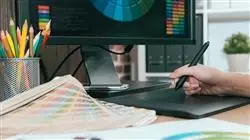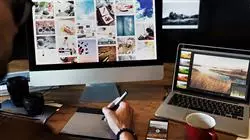University certificate
The world's largest faculty of design”
Description
Learn how to turn ideas into multimedia projects of impact and notoriety with the most up to date knowledge of this sector in a convenient and flexible professional master’s degree"

Through an exclusive methodology, this professional master’s degree will take you into the territory of audiovisual culture. The graphic design professional needs to know the audiovisual phenomena that move in the same paradigms as graphic communication. The influence of some media on others, the different combinations of media and the new graphic products that incorporate different techniques and approaches from other communicative areas are a knowledge that will open new lines of thought and work.
In this sense, having knowledge in all possible aspects of work is a window to very interesting possibilities and explorable paths.
Therefore, this program will address the aspects that a designer needs to know to plan, develop and finalize any audiovisual project. An educational path that will scale the student's skills to help them achieve the challenges of a top professional.
Multimedia Design is presented as a viable option for a professional who decides to work independently but also to be part of any organization or company. An interesting avenue of professional development that will benefit from the specific knowledge that we now make available to you in this program.
This program will allow you to enhance your skills and update your knowledge in Multimedia Design"
This professional master’s degree in Multimedia Design contains the most complete and up to date educational program on the university scene. The most important features of the program include:
- Development of a large number of case studies presented by experts
- Graphic, schematic, and highly practical contents
- The latest developments and cutting-edge advances in this area
- Practical exercises where the self evaluation process can be carried out to improve learning
- Innovative and highly efficient methodologies
- Theoretical lessons, questions to the expert, debate forums on controversial topics, and individual reflection assignments
- Availability of content from any fixed or portable device with internet connection
A complete and up to date professional master’s degree that will allow you to know all the tools you need to develop multimedia projects, with a clear vision in the practical learning of its use”
The development of this program is focused on practicing the proposed theoretical learning Through the most effective teaching systems, proven methods imported from the most prestigious universities in the world, the student will be able to acquire new knowledge in an eminently practical way. In this way, TECH strives to convert effort into real and immediate skills.
The online system is another of the strengths of the educational program. With an interactive platform that has the advantages of the latest technological developments, the most interactive digital tools are made available. In this way, it is possible to offer a way of learning that is totally adaptable to your needs, so that you can perfectly combine this program with your personal or working life.
Boost your profession by incorporating the professional's perspective, through a complete program designed to teach you how to turn ideas into projects"

A program created to allow you to implement the acquired knowledge almost immediately in your daily practice"
Objectives
With this professional master’s degree, the student will learn to develop a complete Multimedia Design project, promoting creative thinking and providing it with solvency through the specific knowledge of the demands that the sector imposes on its professionals.

You will learn how to decide to express ideas using the most appropriate media in each case to give your multimedia designs the best chance of success"
General Objectives
- Develop a complete Multimedia Design project
- Determine the appropriate materials for its development
- Define the ideal techniques for each graphic communicative situation
- Carry out the whole process of creation of pieces, adapting them to different formats
Specific Objectives
Module 1. Audiovisual Culture
- Acquire the ability to integrate knowledge and generate new knowledge
- Gather and interpret relevant data to make judgments that include reflection on relevant social, scientific or ethical issues
- Be able to convey information, ideas, problems and solutions to both specialized and non-specialized audiences
- Employ convergent and divergent thinking in the processes of observation, research, speculation, visualization and action
- Recognize cultural diversity in the context of contemporary societies
- Develop aesthetic sensitivity and cultivate the faculty of aesthetic appreciation
Module 2. Introduction to Color
- Understand the importance of color in the visual environment
- Acquire the ability to observe, organize, discriminate and manage color
- Apply the psychological and semiotic foundations of color in design
- Capture, manipulate and prepare color for use in physical and virtual media
- Acquire the ability to formulate independent judgments by means of arguments
- Know how to document, analyze and interpret documentary and literary sources with their own criteria
Module 3. Audiovisual Language
- Ability to use information and communication technologies (ICT) in different contexts and from a critical, creative and innovative perspective
- Understand the audiovisual language and its importance
- Know the basic parameters of a camera
- Know the elements of an audiovisual narration, its use and importance
- Be able to create audiovisual narratives, correctly applying usability and interactivity criteria
- Ability to use information and communication technologies (ICT) in different contexts and from a critical, creative and innovative perspective
- Understand the relationship between technology and other fields of human knowledge
Module 4. Motion Graphics
- Create animations with personality and style
- Create a first animation of a character
- Learn notions of time and space to apply in short graphics and visual projects
- Explore and understand the basic principles of animation
- Develop a visual and graphic style with its own identity
- Understand what cartooning is and analyze its development throughout graphic history
Module 5. Design for Television
- Write, develop, produce and coordinate digital design projects in the field of art, science and technology
- Know the scope of television throughout history and nowadays, bearing in mind the new platforms that break the traditional television model
- Understand the importance of the graphic identity of a television channel
- Be critical and analytical of mass media, assessing their advantages and disadvantages
- Get started in the world of graphic composition for television by means of After Effects
- Integrate After Effects design into various types of graphics projects
Module 6. 2D Animation
- Understand that animation is a medium that provides thematic freedom
- Know the means available for the development of 2D animation
- Interrelate 2D and 3D work environments for specific projects
- Optimize the use of resources to achieve new planned objectives
- Know and apply the principles of proportion in animated artistic representation
- Recognize the visual and compositional language in the development of an animation
Module 7. Animation Projects
- Know what stop motion is and its importance in the world of art and cinema
- Learn how to make an audiovisual production using the stop motion technique
- Understand the importance of a good narrative as a first step to create innovative projects that attract attention and work
- Build stories by defining characters, scenarios and events through the planning of a script of the animation and what will be developed
- Use techniques and strategies that encourage the creativity of the participants to create their stories
- Understand the methodology of project-based learning: idea generation, planning, objectives, strategies, resources, testing and error correction
Module 8. 3D Modeling
- Know the basic characteristics of 3D rendering systems
- Model, illuminate and texture 3D objects and environments
- Apply the fundamentals on which the different types of projection are based to the modeling of three-dimensional objects
- Know and know how to apply concepts related to flat and three-dimensional representation in objects and scenes
- Know how to apply the different techniques that exist for modeling objects and use them according to their suitability depending on the geometry
- Know 3D modeling programs and specifically Blender
Module 9. Digital Photography
- Capture, manipulate and prepare the image for use in different media
- Know the basics of photographic and audiovisual technology
- Know the language and expressive resources of photography and audiovisuals
- Know relevant photographic and audiovisual works
- Interrelate the formal and symbolic languages with the specific functionality
- Handle the basic lighting and measuring equipment in photography
- Understand the behavior and characteristics of light, valuing its expressive qualities
Module 10. Typography
- Know the syntactic principles of graphic language and apply its rules to clearly and accurately describe objects and ideas
- Know the origin of letters and their historical importance
- Recognize, study and coherently apply typography to graphic processes
- Know and apply the aesthetic foundations of typography
- Know how to analyze the arrangement of texts in the design object
- Be able to carry out professional work based on typographic composition

An opportunity created for professionals who are looking for an intensive and effective program with which to take a significant step forward in the practice of their profession"
Professional Master's Degree in Multimedia Design
.
Graphic communication is of vital importance for the understanding and development of audiovisual culture and, for this reason, at TECH Global University we have created this program specialized in the processes of creating characters, stories and scenarios in motion. Through the study plan, students will be immersed in the semiotics of the image, in intertextuality, in the hybridization of the arts in current transmedia narratives and in the language of these environments. Regarding the technical aspect, it will deal with the theories of color application, cartooning, 2D animation, design for television, 3D modeling in Blender, stop motion, digital photography and typographic correction. Thanks to this theoretical and practical course, each student will have the essential elements for the development of a style in accordance with his or her identity that will allow him or her to skillfully plan and execute all types of projects in different communicative contexts. Likewise, our program will enable you to become the mediator par excellence of the different expressive media.
Study a Professional Master's Degree in Multimedia Design
.
With this postgraduate program offered by TECH, professionals interested in this area will be able to hone their skills in the creation of pieces that make the most of the possibilities offered by storytelling, properly following the criteria of usability and interactivity. From the mastery in the production, manipulation and presentation of still and moving images, it is possible to outline the analytical-interpretative skills of the visual, breaking down the processes of idea generation, planning, mobilization of strategies and resources and, finally, testing and error correction. This will enable students to make creative decisions, where special importance is given to the convenience of the approaches that guide the narrative and to the valuation of the expressive qualities of the tools used. This way, the graduate will be able to write, develop and coordinate digital design projects aimed at the consistent integration of art, science and technology. Through these, he/she will be able to innovatively promote the communicative exchange of different supports and formats.







